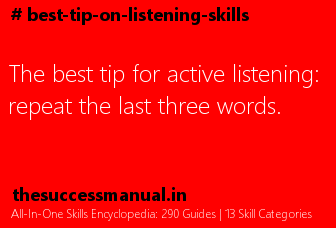Active Listening Skills (How To Be A Great Listener)
Active listening | Listening skills
The best tip for active listening: repeat the last three words.
When people talk about being a great listener, they mean being great at active listening, which is about observing the speaker, the body language etc. , and providing feedback.
Three ways in which we express our understanding:
1. Reflecting back feelings (to get confirmation)
'It seems you are feeling.....'; 'It sounds to me as if .........'; 'You must be really.......(angry, pleased, worried etc.)'
Other examples:
'Let me see if I understand you. Are you saying...?'
'You want...Is that right?'
Ask clarifying and open-ended questions to inquire:
'Give me an example.'
'What would you like to see happen?'
'Anything else?'...'Tell me more.'
2. Paraphrasing
We repeat back to the person what they have said in your own words. Paraphrasing the context (and the content) of their communication, not their emotion.
‘Key word repetition’ is another effective form of paraphrasing. When we are really listening, it is easy to pick out particular words or phrases to encourage the speaker to explain in more detail.
If the speaker is trying to develop a theme, we help them by adding constructively to what the have said. Say,
'How do you mean?'
'What makes you say that?'
'What are you thinking of specifically?'
'Tell me more.'
3. Summarizing
When we summarize what someone has said, you again convey the extent of your active listening.
Condense the information into brief points or themes and focus rambling remarks into crisp phrases. You can introduce the paraphrase or summary with something like:
'As I understand it...'
'If I’ve got it right.....'
'So what you are saying is.....'
And all this time, nod often.
11 Active Listening Skills
- Acknowledge to the speaker that you are actually hearing: Nodding, eye contact etc.
- Active summarizing: Restating what the speaker just said.
- Pick up on the body language and emotions of the speaker, and reflect them back at her: You are affirming that you have reached the same understanding.
- Interpreting like a psychiatrist.
'I see from your uncontrollable twitch that this has upset you. Tell me why…'
This is generally focused on being empathetic, and encouraging people to talk more.
Ask for clarifications, to make sure you understand what your speaker means.
'Are you saying you need ‘drag and drop’ because you need an easy to use interface, or because people will be using a Tablet with no keyboard'?
- Summarizing
This works best with good open ended questions, when you may get a relatively long response, when the speaker goes off-topic sometimes, but you get more useful information.
Make notes of those other topics for follow-up, then summarize the parts of the answer that addressed your initial question.
- Probing
Ask a clarifying question or two to assure the speaker (and yourself) that you understood what they intended you to understand. This can also help you with credibility with the speaker, as it demonstrates some knowledge of or comfort in their domain.
- Giving Feedback
Focus on affirmation of their insights or ideas, instead of criticisms. If you tell someone that their question is stupid, you encourage them to shut down and shut up.
Listen to speakers or panelists in a Q&A session - they regularly start their answer with 'That’s a great question.' The really good ones will say 'That’s a great question, because…' Without the because, the feedback can start to sound like a pre-programmed platitude. Quickly snap off half a dozen 'Great Question. Here’s my answer.' answers without the rationalization, and people will tune it out as noise. If you’re struggling for responses, use anecdotes. 'That’s a great question, I had a client who never asked it - and here’s how the disaster unfolded…'
- Supporting
By supporting the speakers’ worries as being valid, and ultimately resolving those worries, you create loyal customers. If they add their voices to the mix, providing support for the ideas that people present, they will get more and better ideas.
If they follow-up, they can demonstrate a clear cause-and-effect for their customers. 'You said it. We did it.'
- Checking Perceptions
When you’re actively listening to someone, in addition to getting data, you are forming impressions and perceptions. You need to check the validity of those perceptions with the speaker.
You’re also letting the speaker know that you 'get it.'
- Being Quiet
Interviewers use this technique. Silence can make people uncomfortable, so they tend to fill the void - the only way they can, by talking more. While this is effective for confrontational interviews, there are more positive and enabling reason to do be quite.
If you are creating a 'take all the time you need,' positive, supporting silence, they will use that time effectively. The attends and emotional affirmations you’re providing are what make it supporting and not interrogative.
- Extension
This is a variation on the restating technique. Many people you interview will be providing you with data from a discrete perspective. When gathering requirements, you have to find a way to abstract that information into market requirements.
A great way to validate that you’re generalizing the salient parts of their ideas is to extend the ideas.
'I think we can also use this to...'
❤ If you liked this, consider supporting us by checking out Tiny Skills - 250+ Top Work & Personal Skills Made Easy